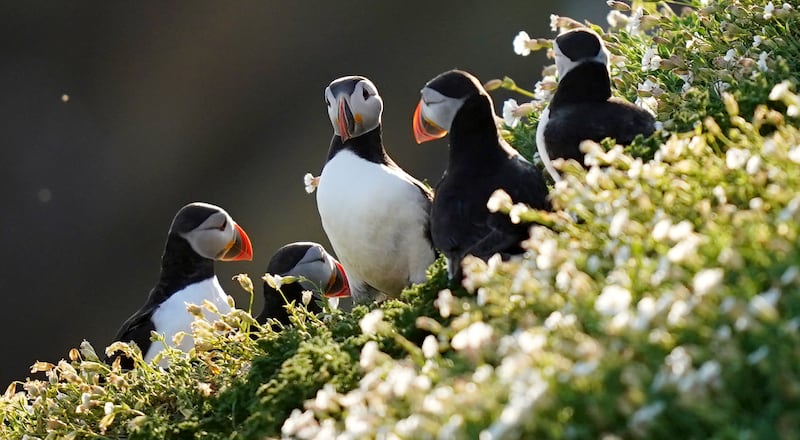Arrive in Kilmore Quay in south Wexford on almost any day in May or June and you’ll see small groups of people waiting to board the Saltee Islands ferry. Each boat takes 12 people with more boats put on in summer season to cater for extra demand.
The journey to the island, which is about five kilometres from the coast, takes about 20 minutes and passengers must be prepared for a wet landing – wading through shallow water across seaweed or stones to reach land – as there isn’t a pier or harbour on the island.
Once on the Great Saltee Island, the larger of the two islands and the only one the owners have granted public access to, visitors disperse across the island, keen to enjoy one of the best places on the east coast to observe breeding seabird colonies.
There are few opportunities these days to sit in silence and simply study the natural world undistracted from interpretative centres, coffee shops and retail outlets. But on the Great Saltee that is exactly what’s on offer. You must bring your own provisions and leave no trace of your visit there. There aren’t any buildings – apart from the private holiday home of the Neale family, who own the island, close to the landing spot – so bringing waterproof clothing to protect visitors from inclement weather is essential too.
RM Block
In her book Phosphorescence, the Australian author Julia Baird describes silence as not just the absence of noise but the absence of noise made by human beings.
“The real joy of silence is not about blocking out the noise, but reconnecting with, or listening to the land,” she writes.
[ Ireland’s largest protected area for birds to be created along Co Wexford coastOpens in new window ]
Visually and aurally connecting with the breeding populations of kittiwakes, guillemots, razorbills and the stars of the show – puffins – is what draws people here. It’s a short walk along a designated path – passing the throne built by the self-titled Prince of the Saltees, the late Michael Neale, some decades ago – to the south coast of the island to observe these nesting birds on the cliffs. The gannets congregate noisily on the southwestern side of the island on rocky outcrops in an impressively large colony. The Saltee Islands are also a breeding spot for grey seals.
And while Malcolm Noonan, Minister of State for Nature and Heritage, recently announced an extension to the protected marine waters off the coast of Wexford – the Seas off Wexford Special Protection Area is now the largest SPA in Ireland – there are always concerns about how well unmanaged wildlife sites (those without wardens) are monitored.
A 2011 National Parks & Wildlife Service (NPWS) study of the Saltee Islands found favourable conservation status of both the habitats and breeding bird colonies there. As well as being an SPA under the EU Bird Directive, the islands are a Special Area of Conservation for their marine habitats (reefs, sea caves and vegetated cliffs) and for the grey seals that breed around the islands in autumn.
Concerns about declining numbers of puffins and manx shearwater on the Great Saltee led researchers from the School of Biological, Earth and Environmental Sciences at University College Cork to check for rats on the island. Their subsequent discovery of significance presence of these rodents resulted in the NPWS carrying out a successful rat eradication project a couple of years ago.
Another UCC study of the human disturbance to the gannet colony on the Great Saltee found that some tourists – especially those looking for that perfect photograph of birds on their nests – got too close to the gannets.
“On one occasion, we saw nine disturbance events over a two-hour period. This led to a 60 per cent reduction in breeding success compared to birds at undisturbed parts of the colony,” says Debs Allbrook, who examined the level of disturbance by tourists on the island in 2017.
As part of her research, Allbrook conducted an experiment to see if tourists would pay attention to a sign warning them that their actions could be damaging. And, she found the vast majority of people stayed away from the birds and fewer disturbances were observed.
“This showed that it was largely lack of knowledge that led to the disturbances in the first place. People did not understand the harm they were causing. When approaching a bird on a nest like that, because they seem fairly unfazed, people believe they are fine to go right up to them.
“We showed that in fact, these ‘harmless’ encounters could have much more serious effects than we thought. The disturbance often caused confusion in the colony and it only took a second for a gull to zip in and steal an egg,” she says.
John Quinn, professor of ornithology at UCC, says he remains concerned that visitors – and photographers in particular – are getting too close to puffins’ nests during their breeding season
The absence of tourists to the Great Saltee during Covid allowed breeding numbers of gannets to rise again. And now a permanent sign is in place close to the gannet colony warning visitors to stay at least six metres from the nesting birds to prevent nest abandonment or the death of eggs and chicks by gulls or exposure.
Allbrook’s study, which was published in the Journal for Nature Conservation in December 2020, concluded that photographers were the only visitor group that didn’t always comply with the sign.
On the day of our visit, we feel a particular pleasure in seeing some puffins up close as we sit on the grass near the south-facing cliffs. However, our joy is somewhat tainted by the realisation that the precise reason they are near us is that we are too close to their nesting burrows in the grassy areas above the cliffs. John Quinn, professor of ornithology at UCC, says he remains concerned that visitors – and photographers in particular – are getting too close to puffins’ nests during their breeding season.

“There will be reputational damage to Ireland if the seabird colonies aren’t managed well. We’ve seen people putting rubbish down burrows and sitting on the grass next to their burrows, preventing the puffins from going into their nests,” he says. Quinn says signs are now needed to keep people further from the puffins’ nesting sites.
Speaking at the recent launch of the newly designated Seas off Wexford SPA – which adjoins the existing Saltee Islands SPA – Niall Ó Donnchú director general of the NPWS says: “The 20 species protected at this site are some of our rarest and most threatened birds and these waters are a valuable feeding resource for seabirds that return every spring to Wexford’s coastal and island colonies to breed.”
These SPAs are also important as feeding and roosting opportunities for overwintering marine birds or those in transit to other destinations outside of the summer months, he adds.
Making reference to Ireland’s future plans for large offshore wind farms off Waterford and Wexford, Minister for Energy Eamon Ryan said recently that 80 per cent of the 8,000 kilometres surveyed off the south coast were excluded for development due to special protection areas for wild birds and to protect marine diversity, key spawning ground and the Saltee Islands. There is a southern DMAP designating areas for development off the Waterford and Wexford coast separate to the Saltees.
Dr Mark Jessopp, lecturer in zoology at UCC School of Biological, Earth and Environmental Sciences, says seabirds usually fly below the levels of the rotator blades on offshore wind farms.
“There is very little risk from collision. And gannets, for example, which fly higher, will fly lower to avoid the sweep areas of the turbines,” he notes.
What researchers don’t yet fully understand is whether some preferred feeding grounds will be close to future wind farms. “They might impact feeding grounds but if there is a lot of food, the birds will overcome their natural aversion and move in to follow the food,” he says.
- Sign up for push alerts and have the best news, analysis and comment delivered directly to your phone
- Join The Irish Times on WhatsApp and stay up to date
- Listen to our Inside Politics podcast for the best political chat and analysis






















